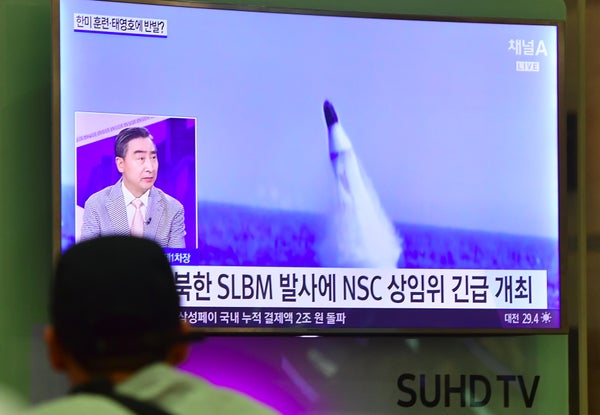Editor’s Note (8/29/17): Scientific American is re-posting the following article, originally published September 9, 2016, in light of claims by South Korean and Japanese officials that North Korea fired a ballistic missile over Hokkaido, Japan’s second-largest island, early Tuesday morning. The missile flew about 2,700 kilometers before landing in the Pacific Ocean to the east of Japan. This was the third time North Korea has fired a projectile over Japan since 1998.
The U.S. awoke Friday morning to news that North Korea has set off its largest-ever nuclear weapon test explosion. The 10-kiloton detonation—the country’s second this year and fifth since 2006—follows its launch of three ballistic missiles toward the Sea of Japan earlier this week and is North Korea’s first atomic explosion since it put a satellite into orbit in February. What all of this means for the rest of the world’s security—South Korea’s and Japan’s in particular—is anyone’s guess. The ramping up of ongoing nuclear and ballistic missile tests, however, feeds growing concerns that Kim Jong-un’s regime will soon be able to make good on its threats to target parts of the U.S. as well as Washington’s allies in the region.
The latest nuclear test falls on the 68th anniversary of Kim Il-sung’s founding of the Democratic People’s Republic of Korea. The country has been open about its plans to be able to use nuclear-armed missiles to target U.S. territory and places including South Korea and Japan, where the U.S. has a major military presence. The biggest question is how long it will take to put a nuclear warhead atop of one of those boosters and fire it accurately. “Since North Korea’s last satellite launch, Pyongyang’s illicit nuclear and missile activities have continued unchecked,” says Kelsey Davenport, director for nonproliferation policy at the Arms Control Association, a Washington, D.C., think tank. North Korea has expanded its stockpile of fissile material for nuclear warheads and has increased the range and diversity of its ballistic missiles. That includes developing a motor that uses solid propellants for those missiles as well as the ability to launch them from submarines.
On supporting science journalism
If you're enjoying this article, consider supporting our award-winning journalism by subscribing. By purchasing a subscription you are helping to ensure the future of impactful stories about the discoveries and ideas shaping our world today.
Pyongyang can likely mount a warhead on its short- and medium-range ballistic missiles, Davenport says. “The reliability and accuracy of these systems might be low, but these missiles would put South Korea, Japan and U.S. military installations in the region within range,” she adds. “North Korea seems to be taking steps toward developing an intercontinental ballistic missile capable of targeting the U.S., but it is unlikely that Pyongyang could deploy such a missile in the next decade.”
The U.S. Geological Survey initially reported North Korea’s latest nuclear test as a magnitude 5.3 earthquake but later classified the event as an explosion. The detonation surpassed the 6- to 7-kiloton blast in February 2013 and the 4- to 6-kiloton test in January of this year. Pyongyang claimed the latter was a hydrogen bomb, but many experts doubt that claim because a hydrogen bomb blast would have been hundreds of times more powerful. For perspective, the “Little Boy” atomic bomb dropped on Hiroshima on August 6, 1945, was around 16 kilotons (pdf).
The White House responded to reports of Friday’s test by restating to South Korean President Park Geun-hye and Japanese Prime Minister Shinzo Abe the “unshakable U.S. commitment to take necessary steps to defend our allies in the region, including through our deployment of a Terminal High Altitude Area Defense (THAAD) battery to [South Korea] and the commitment to provide extended deterrence guaranteed by the full spectrum of U.S. defense capabilities.” THAAD is a truck-mounted antiballistic missile system designed by Lockheed Martin to shoot down short-, medium- and intermediate-range ballistic missiles.
North Korea’s defiance of public condemnation and economic sanctions indicates those approaches are not working, says Bruce Cumings, History Department chair at the University of Chicago. “North Korea is merrily running along testing medium-range missiles, A-bombs, etcetera, and pressuring the U.S. to do something about it,” Cumings says. “I think the U.S. should negotiate a cap on their missile and A-bomb testing, to try and arrest or stop the rapid development of their arsenal. Under the current policy, Obama is just sitting still, watching this arsenal grow.”
